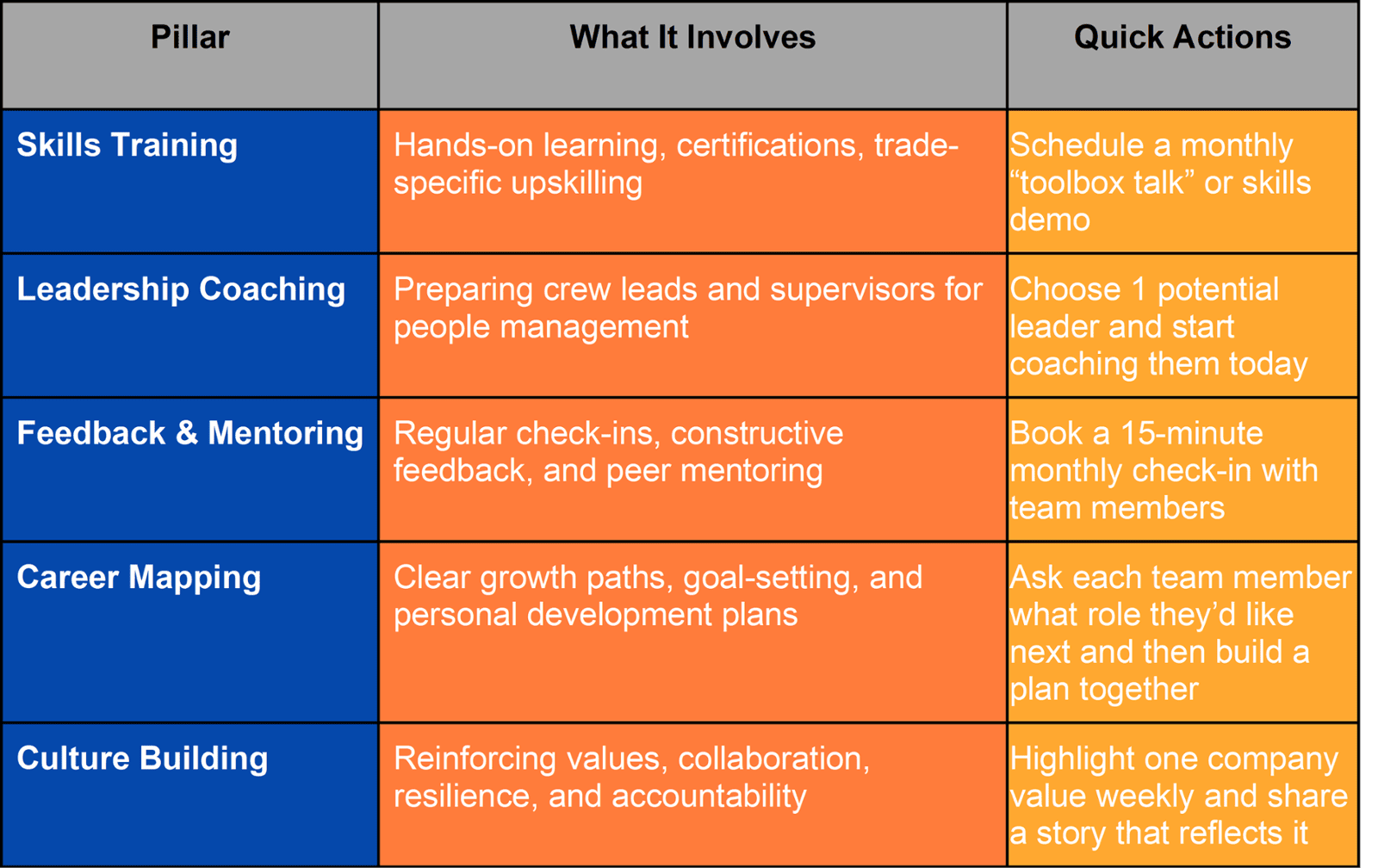Stronger Teams Start with Smarter Development.

In businesses across Canada, many owners and leaders face a harsh truth: failing to invest in employee development drains their bottom line.
While it’s tempting to focus solely on production schedules, client work, and staying ahead of competitors, overlooking your people's growth comes at a high cost that doesn’t show up in your books until it’s too late. Let’s unpack this hidden cost and examine how development or the lack of it impacts engagement, productivity, retention, and business growth.
What Happens When You Don’t Develop Your Team?
You’ve probably heard the saying, “What if we invest in our people and they leave? But what if we don’t and they stay?” Here’s what staying looks like when people aren’t growing:
1. Low Engagement = Low Productivity
According to Gallup, only 23% of employees globally feel engaged at work, and a big reason is the lack of learning and development opportunities. When people don’t see a path forward, they check out quietly.
Disengaged team members:
- Show up late or call in more often
- Do the bare minimum
- Don’t offer new ideas or solutions
- Undermine morale
This affects everything from job site safety to quality control. Disengaged employees, on average, cost companies 18% of their annual salary in lost productivity.
2. High Turnover Drains Your Profits
Recruiting, onboarding, and training new hires is expensive. The Work Institute’s Retention Report shows that the average cost of turnover is 33% of an employee’s annual salary.
If a tradesperson making $60,000 walks out, that’s a $20,000 hit. Now multiply that across a team of 25, and suddenly you’re dealing with a serious financial leak.
Most employees don’t leave because of money. They leave because of:
- Lack of growth
- Poor management
- Limited feedback or recognition
- Weak team culture
All of which are solvable with better development practices.
3. Missed Opportunities to Promote from Within
Skilled labor is hard to find, yet many businesses fail to develop future supervisors or crew leads from within.
When you don’t have a development plan, you’re stuck:
- Hiring externally (with uncertain results)
- Overloading your top people
- Losing business momentum
By contrast, businesses that upskill and promote their teams see improved performance, higher retention, and more substantial culture alignment.
What Employee Development Looks Like

(Hint: It’s More Than Training)
When most people hear “employee development,” they think of formal training or expensive courses. But real development—especially in blue-collar and trades-based businesses—is much more practical and hands-on.
It’s about building everyday capabilities that help your team adapt, lead, solve problems, and grow with your business. And it’s not just for new hires—your most experienced crew members benefit too, especially when they’re stepping into leadership roles or mentoring others.
At Blueneck, we consider five pillars of effective development that any business can apply. You don’t need a full HR department to make progress. You just need a plan, a bit of structure, and a commitment to helping your people succeed.
The Business Case for Investing in Your People
Still unsure if it is worth the cost and time? Here is what the data says:
- Higher Productivity: According to a McKinsey workforce transformation study, employees receiving regular development support are 15% more productive.
- Stronger Retention: Organizations with strong learning cultures have 30–50% higher retention rates. That means lower hiring costs and more experienced, capable teams.
- Fewer Safety Incidents: Better-trained and more engaged employees are up to 70% less likely to cause workplace accidents, especially on construction or manufacturing sites.
- Improved Innovation and Problem-Solving: According to Deloitte, companies that develop their employees consistently outperform their competitors in innovation.
Common Excuses and Why They Don’t Hold Up

“We don’t have the time.” Every hour spent on development saves hours of rework, micromanaging, or replacing team members later.
“We can’t afford it.” You’re already paying the price through inefficiencies, turnover, and missed growth. Development is an investment, not a cost.
“Our guys won’t go for it.” Most workers want to grow if it feels practical, relevant, and backed by leadership. It starts with how you frame it.
Case Example: What It Looks Like in Real Life
So, what does employee development look like in action?
An example is a mid-sized commercial construction firm in Central Canada with 22 employees. Like many others in the industry, they were facing this situation:
The Challenge
- High turnover among junior laborers
- Tension between supervisors and newer crew members
- Missed deadlines due to communication breakdowns
- The shop manager was burned out
Leadership realized they were reacting to problems instead of preventing them and that employee development had been an afterthought.
With guidance and leadership coaching, they implemented a development program based on these 5 Pillars:
- Skills Training: Weekly hands-on demonstrations led by senior tradespeople
- Leadership Coaching: One-on-one sessions with forepersons to improve communication and delegation
- Feedback & Mentoring: Monthly check-ins for all employees and buddy-pairing for new hires
- Career Mapping: Introduced basic growth paths from apprentice to lead hand
- Culture Building: Reinstated morning huddles to align values and goals
The Result
Within 90 days:
- Turnover dropped significantly
- Site delays decreased
- Supervisors reported less stress and more team accountability
- Two junior crew members were promoted to assistant lead hand roles
- Shop manager reported less stress and better team communication

Summary: The Hidden Cost of Poor Employee Development
When employee development is overlooked, it doesn’t just affect your team—it affects your operations, your bottom line, and your ability to grow. These hidden costs often show up as slow erosion rather than sudden breakdowns—but the impact is just as real.
On the right, you’ll see a snapshot of four common development gaps, what they cost your business, and the practical solutions that Blueneck recommends to address them.
Whether you’re losing people to turnover, struggling to build internal leaders, or simply seeing lower engagement on the shop floor, there’s a clear path forward. And it doesn’t have to be complicated—start with one pillar, one conversation, or one plan at a time. A few small changes today can build long-term momentum for your business and your people.
So, Where Do You Start?
If you’re ready to stop leaking time, money, and energy due to underdeveloped teams, here are a few practical first steps:
1. Talk to your team: Ask what they want to learn or where they feel stuck.
2. Build a simple development plan: Start small: even one-on-one check-ins or skills workshops make a difference.
3. Identify future leaders: Begin coaching those who show initiative now - before you need them.
4. Partner with experts: A business coach and advisor like Blueneck can help you design development programs tailored to your size and goals.

You Can’t Afford Not to Develop Your Team
The cost of poor employee development might not appear on a balance sheet, but it is everywhere else: in late jobs, safety mishaps, missed bids, and stressed-out managers.
Investing in your people is the most sustainable way to build a resilient, profitable business. It’s not about fancy perks or polished programs, it’s about clear plans, meaningful feedback, and helping people get better at what they do.
And the best part? You don’t have to do it alone.
So where do you start? If you’re ready to stop leaking time, money, and energy due to underdeveloped teams, here are a few practical first steps:
1. Talk to your team: Ask what they want to learn or where they feel stuck.
2. Build a simple development plan: Start small: even one-on-one check-ins or skills workshops make a difference.
3. Identify future leaders: Begin coaching those who show initiative now - before you need them.
4. Partner with experts: A business coach and advisor like Blueneck can help you design development programs tailored to your size and goals.
Ready to Grow Your People and Your Business?
You don’t need a corporate HR team or complex systems to start developing your people. What you need is a clear plan, a bit of structure, and the right support.
At Blueneck, we help business owners and managers across Canada build stronger teams through coaching, leadership development, skills training, and practical team strategies that fit the pace of blue-collar work.
Whether you’re trying to reduce turnover, promote from within, or build more accountability on the floor, we’ll work alongside you to:
- Identify your team’s biggest roadblocks
- Create a plan that fits your size and reality
- Coach leaders to give better feedback, delegate well, and grow their people
- Build a culture where performance and pride go hand in hand
Your business is only as strong as your people. Let’s invest in both—together.
Visit www.blueneck.ca to learn more or contact us for a free consultation.

